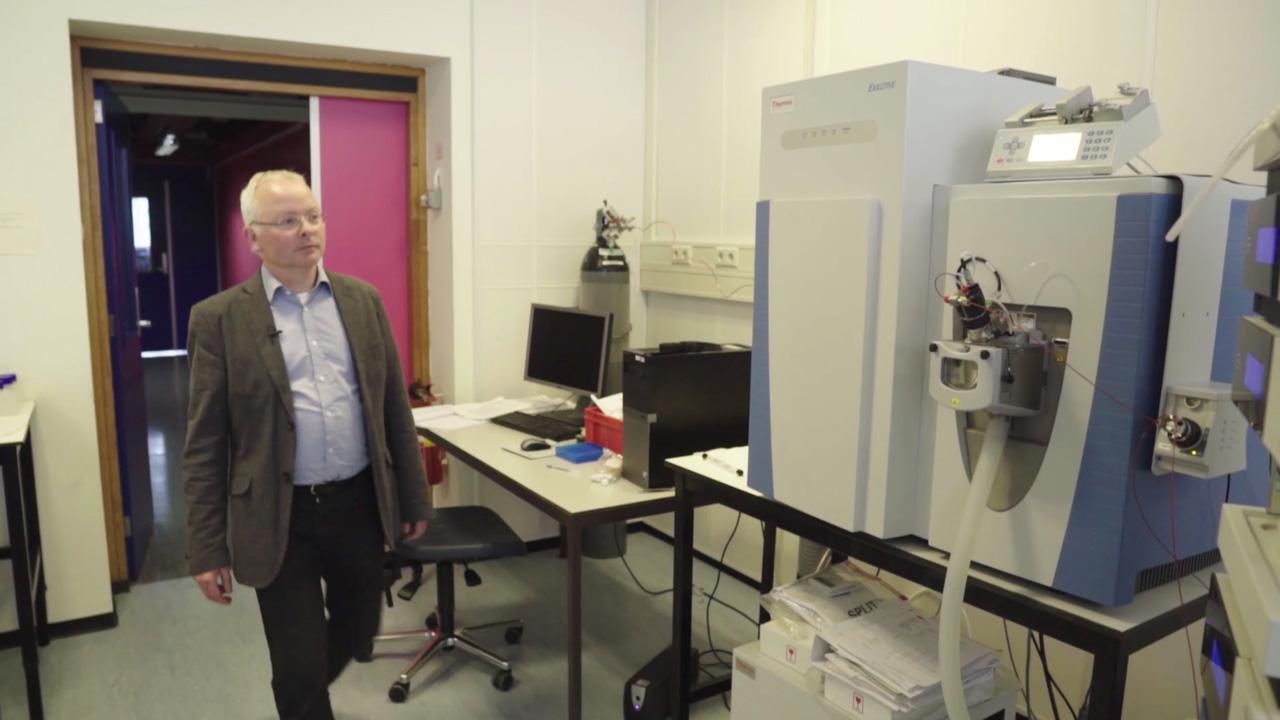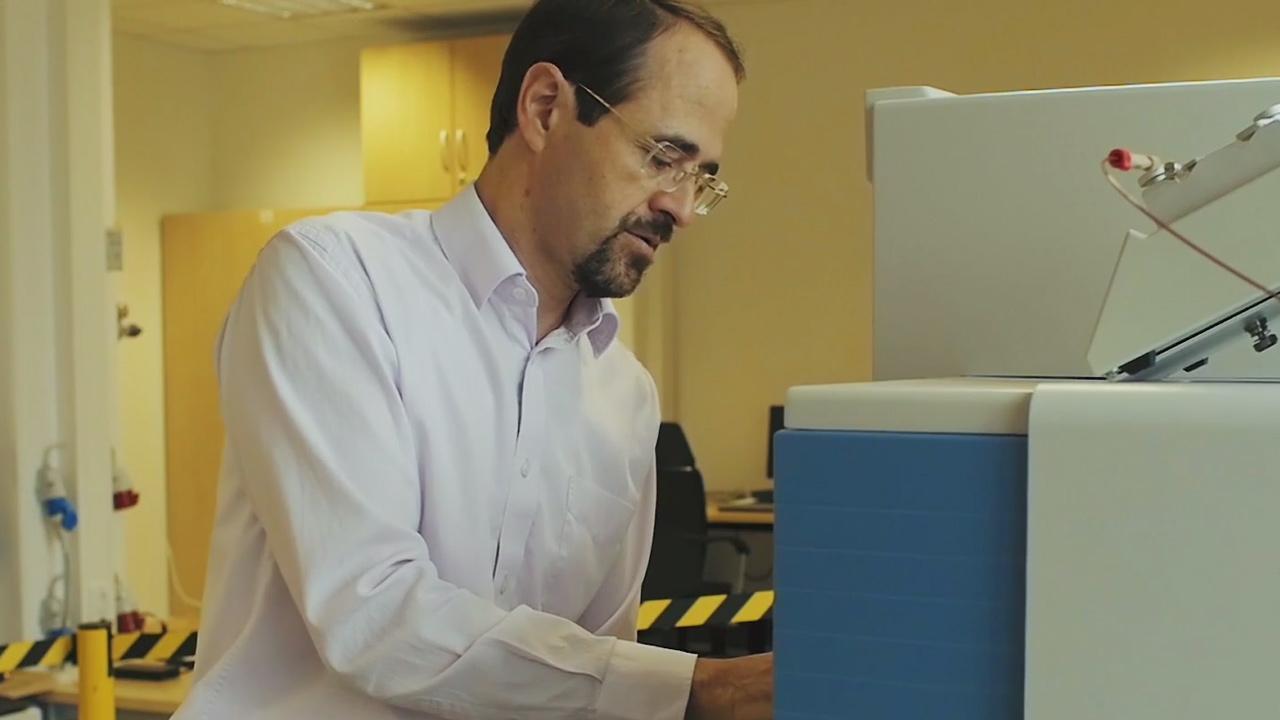Mixtures of 3 MDa and 4 MDa hepatitis B virus capsids analyzed under charge reducing conditions span a wide mass range between 27,000 and 36,000 m/z. The spectrum contains well-resolved charge states for both particles and shows no bias for the 25% smaller 3 MDa particle.

High resolution mass spectrometry that lets you see what you haven't before
The Q Exactive UHMR Hybrid Quadrupole-Orbitrap Mass Spectrometer is Thermo Fisher Scientific's first
mass spectrometry platform to combine substantially increased sensitivity and mass resolution at high m/z, with MS2 and pseudo-MS3 capabilities – creating a unique and powerful analytical solution for the investigation of structure and heterogeneity of protein complexes. With its superior ability to perform native intact mass and top-down analyses, the Q Exactive UHMR mass spectrometer provides unprecedented structural detail which you cannot see with other methods, enabling deeper understanding of protein function, disease mechanisms, potential drug targets, and biotherapeutic compounds. Tackle complexity with the Thermo Scientific Direct Mass Technology mode to provide insights into complex macromolecules by adding charge detection capabilities.
Key benefits of the Q Exactive UHMR Hybrid Quadrupole-Orbitrap mass spectrometer
Decipher complexity with clarity
Add on Direct Mass Technology mode for samples too complex to resolve by ensemble measurements for direct and accurate mass determination with charge detection. Define small changes to larger molecules with exquisite detail to unlock new insights into the identification and characterization of proteoforms, biotherapeutics, and next generation drug modalities.
| Confidently resolve small mass differences | Conserve precious sample | Perform native top-down analysis of protein complexes | Characterize intact native protein assemblies, including membrane proteins |
|---|---|---|---|
| Analyze intact MegaDalton assemblies and resolve small differences in masses that reveal key ligands, modifications and interactions for better understanding of biological processes. | With orders of magnitude enhanced sensitivity at high m/z, make high-confidence measurements, even if you have very small amounts of sample to work with. | Ultra-high mass quadrupole selection up to 25k m/z and higher fragmentation efficiency in the injection flatapole and HCD cell region allow native top-down analysis. | By varying the in-source trapping energy, the instrument can release protein subunits for top-down sequencing or, with gentle activation, retain membrane proteins bound to multiple ligands allowing whole complex analysis. |
How does in-source trapping work in ultra high-resolution spectrometry?
In-source trapping gently desolvates non-covalent protein complexes and efficiently removes detergent micelles for the analysis of intact membrane proteins and protein complexes. When desired, in-source trapping provides dissociation of non-covalent protein complexes into subunits for subsequent top-down analysis.
Protein-nucleic acid assemblies
The Q Exactive UHMR mass spectrometer enables native MS analysis of large protein–nucleic acid assemblies that require high resolution and very efficient transmission in the ultra-high mass range.
The ultra-high mass selection quadrupole can be used to isolate the 4 MDa HBV particle at m/z 25,000 for subsequent fragmentation. The Q Exactive UHMR instrument confidently detects ions with m/z values up to 80,000 m/z. Here, the tandem MS spectrum of the 4 MDa HBV capsids at 300 eV HCD energy shows sequential ejection of up to 17 out of the 240 copies of the capsid protein.
Intact membrane proteins
Novel in-source trapping permits native MS and native top-down analysis of membrane proteins and membrane protein complexes together in one instrument.
Protein-nucleic acid assemblies
The Q Exactive UHMR mass spectrometer enables native MS analysis of large protein–nucleic acid assemblies that require high resolution and very efficient transmission in the ultra-high mass range.
The ultra-high mass selection quadrupole can be used to isolate the 4 MDa HBV particle at m/z 25,000 for subsequent fragmentation. The Q Exactive UHMR instrument confidently detects ions with m/z values up to 80,000 m/z. Here, the tandem MS spectrum of the 4 MDa HBV capsids at 300 eV HCD energy shows sequential ejection of up to 17 out of the 240 copies of the capsid protein.
Intact membrane proteins
Novel in-source trapping permits native MS and native top-down analysis of membrane proteins and membrane protein complexes together in one instrument.
Featured content on high-resolution mass spectrometry
Video
Prof. Albert Heck, University of Utrecht, and Alexander Makarov, Thermo Fisher Scientific, discuss the developing field of native MS.
Webinar
In this symposia Prof. Dr. Albert J.R. Heck discusses new approaches for structural proteomics workflows for crosslinking and native MS.
Webinar
Q Exactive UHMR MS enables the characterization of megadalton complexes and dynamic structure-function relationships.
Case study
Oxford Mass Technologies (OMass) specializes in native mass spectrometry platforms for multidimensional analysis of challenging protein targets for the biopharmaceutical industry. Read about how they are using new technology for advanced protein characterization.
Blog
In this blog we discuss the development of the Q Exactive UHMR instrument and highlight the improvements from the Exactive EMR instrument in advancing protein characterization.













